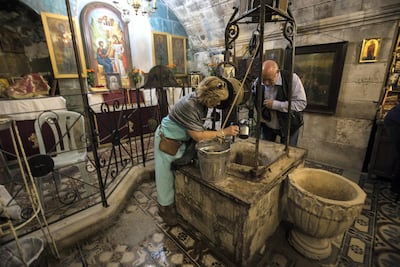The main road through Balata, the largest Palestinian refugee camp in the Israeli-occupied West Bank, is rough and worn.
Balata, near to the Palestinian city of Nablus, is infamously tough and troubled. But take a sharp right off the main street, head towards some high-gated and graffitied walls, step through a heavy door – and suddenly you are in a quiet, calming and colourful abode.
You are in St Photini’s Greek Orthodox Church, which is built on top of Jacob’s Well, and serves as priest Archimandrite Ioustinos’s home.
White-bearded cleric Fr Ioustinos, 77, has been the custodian of Jacob’s Well and of the surrounding church complex since 1980.
Jacob’s Well is holy in Christian, Jewish, Muslim and Samaritan teachings. Tradition says it is where Jacob once camped 4,000 years ago, and where Jesus also passed through, holding a conversation with a Samaritan woman, after whom the church is named.
St Photini’s is a breathtaking, ornate montage of eastern Orthodox-style paintings, sculptures, stained glass and mosaics.
Fr Ioustinos, dressed in his priestly black robe and cap and carrying a cane, is the force behind the art.
He has painted nearly everything, some of it while holed up in the church complex when Israeli soldiers retook control of Nablus during the second Intifada, or uprising, that began in 2000.
Fr Ioustinos says his favourite painting is one depicting Jesus surrounded by the 12 disciples, which he painted on the church’s ceiling over six months.
It is rare for a Greek Orthodox priest living among Palestinians to learn Arabic. But Fr Ioustinos speaks it fluently and said he learnt the language through his decades of work in the region.
"I never formally studied Arabic," he tells The National. "I learnt it from people."
Born in Greece, Fr Ioustinos studied gold and silversmithing, but his heart was elsewhere.
He arrived in Palestine in 1960, when Jordan controlled the West Bank.
In the decades since, he watched history unfold from positions in Bethlehem and Beit Jala, a Palestinian Christian town near Bethlehem.
He came upon his current position in Nablus at a disturbing time.
In 1979, a Jewish Israeli, who suffered from mental illness, stormed the church and stabbed Fr Ioustinos’s predecessor to death.
The assailant was caught after trying to return and do the same to Fr Ioustinos, he says. This scared the priest. But so did many other events in the coming years.
During the Second Intifada in the mid-2000s, Nablus was one of the centres of violence between Israeli soldiers and Palestinians.
Many of the suicide bombers who struck at Israel came from Nablus. Israeli forces retook West Bank cities and imposed curfews and closures. Fr Ioustinos, stuck in his church, turned to painting to pass the time.
He also began to think of ways to remodel the church. Over the centuries various churches have graced the complex, built by Byzantines and others who sought control. In the early 20th century, an earthquake damaged much of the church’s foundations.
Fr Ioustinos said he had sought a permit from the Israeli authorities to rebuild the church but they refused and even prosecuted him when he started to dig anyway.

After the chaos of that second uprising, when the Palestinians took control of the city under the Oslo Accords, Yasser Arafat – then the president of the Palestinian Authority – gave Fr Ioustinos a permit to build.
Arafat even offered money to cover the costs but Fr Ioustinos says he refused the funding to preserve the church’s independence.
“I didn’t take the money from him so there wouldn’t be problems in the future,” he says. “Why? Because this place belongs to three religions: Jews, Christians and Muslims.”
Fr Ioustinos does not just paint what is on his mind. Under the traditions of the Greek Orthodox Church, he paints icons, mainly of Jesus, Mary, saints and angels in a style that Eastern Orthodox artists have followed for centuries.
“I can’t just do what I like,” he says.
“Michaelangelo made art, not icons. This is the life of the Greek Orthodox.”
On an exterior wall of St Photini’s church, Fr Ioustinos has made a mosaic depicting himself.
This has been placed next to a simply decorated grave that he built for himself 10 years ago.
The elderly Greek priest is planning to see everything through to the end but he wishes more foreign tourists would make the trek to his personal and religious West Bank paradise, in spite of the problems facing that part of the world.
“For 60 years I’ve been in a holy hand,” he says.
“All of the tourists who come to Israel and Palestine should come here.
“It’s a religious, archaeological and historical place. Everything is found here.”

